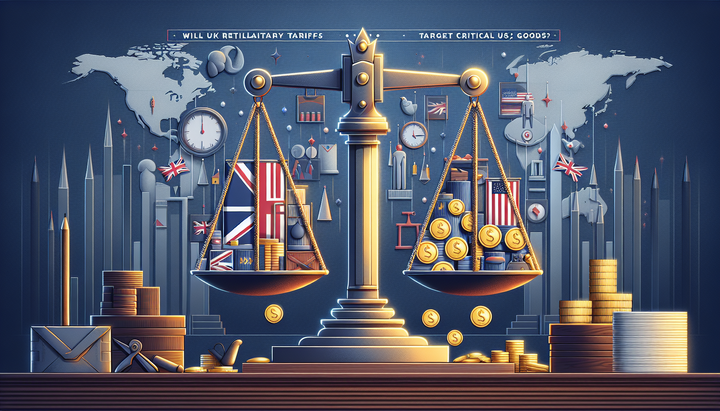Will Trump's Tariffs Redefine Pharma Growth?

Introduction: A Pivotal Moment in U.S. Economic Policy
The recent imposition of sweeping tariffs by President Donald Trump marks a turning point in U.S. economic policy, reverberating across global markets. One industry feeling the impact profoundly is the pharmaceutical sector. US pharma giant Eli Lilly, led by CEO David Ricks, has voiced concerns that these tariffs could hinder investment in research and development (R&D) and disrupt global supply chains. In this analysis, we explore how the new trade measures could reshape the future of pharmaceutical innovation, uncovering the complex dynamics between trade policy, manufacturing relocation, and economic growth.
Trump's Tariffs Explained
At its core, the newly imposed tariffs target imports from around the globe with the intention of bringing jobs and boosting domestic production. However, while the tariffs exclude certain critical sectors—such as pharmaceuticals and microchip manufacturing—companies like Eli Lilly are still feeling the indirect effects. The tariffs have created uncertainty about cost management, pricing strategies, and ultimately, the overall economic benefits promised by the administration. Industry leaders now face a crossroads: adapt to a shifting policy landscape or risk stagnating their growth trajectory.
Insights from US Pharma Leadership
David Ricks, the boss of Eli Lilly, has candidly described the tariffs as a watershed moment in U.S. policy, remarking, "I think it's a pivot in US policy and it feels like it'll be hard to come back from here." Such forthright commentary points to fundamental concerns within the industry. While some companies might consider relocating parts of their manufacturing operations to mitigate tariff costs, Ricks is skeptical that these moves will generate the promised increase in domestic revenue. Instead, he warns that the tariffs could lead to significant cutbacks in R&D spending—a particular worry for a sector where innovation is paramount.
Global Supply Chains and Manufacturing Strategies
The pharmaceutical industry is built upon extensive, intricate global supply chains. Eli Lilly, with its operations stretching across the US, Europe, and Asia, exemplifies this interconnectedness. The tariffs, even if designed to bolster domestic production, fail to consider that substantial parts of the value chain already exist outside the United States. Key points include:
- Cost Absorption: With product prices capped in regions like Europe and the US, companies must absorb additional costs rather than transferring them to consumers.
- Relocation Risks: Shifting manufacturing overseas is not a simple remedy. Even if production facilities move, the innovation and R&D, which occur predominantly in the US, remain vulnerable to policy changes.
- Research & Development Impact: Ricks predicted that the first casualty of cost-cutting would be cuts in R&D expenditures. This could slow down the development of new drugs, affecting patient outcomes and long-term industry growth.
These factors combine to create a precarious situation where the intended boost in domestic production may not materialize, potentially undermining the competitive edge of U.S. pharmaceutical companies.
The Future of Pharmaceutical Innovation
Innovation in the pharmaceutical sector depends heavily on sustained investments in research and development. Currently, about 70% of global R&D activities in the industry occur in the United States. Tariffs, by straining cost structures, threaten this delicate balance. The potential consequences include:
- Reduced R&D Investments: With necessary funds being redirected to absorb tariff costs, companies might delay or cancel promising research projects, leading to fewer breakthroughs in medicine.
- Competitive Disadvantage: As companies face budget constraints, they risk falling behind competitors in regions with more favorable trade conditions—a risk that extends beyond just pharmaceutical firms.
- Patient Impact: Fewer innovations translate into a slower arrival of new therapies and treatments, potentially impacting public health outcomes on a global scale.
These issues force stakeholders to reckon with the long-term implications of a policy designed to protect domestic jobs but which may inadvertently stifle innovation and compromise future growth.
UK’s Declining Status in Life Sciences
Beyond the American context, the interview with David Ricks highlighted concerns about the UK's once-thriving status as a hub for pharmaceutical research and life sciences. Ricks pointed out that while the UK has traditionally offered a stable regulatory environment and robust intellectual property protections, its market dynamics have shifted unfavorably in recent years. Key observations include:
- Regulatory Delays: Slow regulatory processes are a significant hurdle, hampering the rapid uptake of new medicines.
- Market Underperformance: Compared to other European markets like Germany, where a larger health budget translates to greater spending on novel treatments, the UK risks falling behind.
- Investment Decline: There is a noticeable reduction of capital funneled into UK life sciences, which may impact future competitiveness and innovation potential.
These concerns underscore the broader impact of trade policies and domestic market conditions on a nation’s global standing in high-value industries such as pharmaceuticals.
Economic Impact Beyond the Pharmaceutical Sector
The ramifications of these tariffs are not confined to the pharmaceutical industry. Other sectors, such as electronics, software, and advanced manufacturing, also stand to be affected. The policy mirrors a broader governmental attempt to control the economic balance between domestic and international production. Consider the following broader impacts:
- Supply Chain Reconfigurations: Companies across multiple industries may need to rethink their supply chain strategies, opting to localize production to avoid tariffs even if it means higher operational costs in the short term.
- Global Economic Relationships: The tariffs contribute to increasing economic tensions between the US and key trading partners, potentially prompting retaliatory measures that could exacerbate global trade disruptions.
- Innovation Ecosystems: Similar to the pharma industry, sectors heavily reliant on innovation might see reduced investments in research, impacting long-term technological progress.
The interconnectivity of these industries means that any policy shift in one area can ripple across the global market, leading to a more fragmented international economic landscape.
Strategic Adaptations and Corporate Responses
How are companies adjusting to this new era of increased protectionism? Several strategies are emerging as businesses strive to navigate the challenges posed by tariffs:
- Rebalancing Supply Chains: Firms are actively evaluating their production networks to weigh the benefits of relocating certain manufacturing components. For instance, Eli Lilly continues with its planned investment in an $800m facility in Ireland, highlighting a trend where companies seek alternatives to mitigate tariff exposure.
- Investing in Efficiency: Many businesses are doubling down on operational efficiencies to offset increased costs. This includes automation, lean manufacturing techniques, and more rigorous cost management protocols.
- Diversifying Markets: By expanding their reach into new international markets, companies can reduce their reliance on any single economic region. This diversification also serves to buffer against policy shifts in one particular country.
- Innovative R&D Models: Recognizing the threat to research funding, some industry leaders are exploring collaborative R&D ventures and public-private partnerships to maintain momentum in innovation despite tighter budgets.
These strategies highlight the resilience and adaptability of modern corporations. Even as policies shift, the drive to innovate and maintain competitive advantage remains strong.
Implications for Global Trade and Economic Policy
The discussion surrounding Trump’s tariffs extends beyond the immediate concerns of cost management and market disruptions. This policy shift signals a broader trend towards economic nationalism and protectionism, with several lasting implications:
- Wider Policy Cascades: Tariffs in one sector may pave the way for similar measures in other critical industries, potentially initiating a domino effect of policy changes worldwide.
- Diplomatic Strains: As countries like the EU and China react to U.S. trade policies, the resulting diplomatic tensions could complicate global economic negotiations and trade agreements.
- Market Uncertainty: Persistent uncertainty around trade policies can make investors more cautious, leading to reduced capital flows and lower overall economic activity, especially in sectors that rely heavily on cross-border collaborations.
These ramifications underscore the delicate balancing act that governments must perform when crafting policies that protect domestic interests while maintaining global trade relationships.
The Road Ahead: Challenges and Opportunities
While the challenges posed by these new tariffs are significant, they also bring opportunities for strategic realignment. Industry experts suggest that companies that innovate in the face of adversity may emerge stronger. Key points for the future include:
- Enhanced Innovation Ecosystems: Tightened budgets may force companies to prioritize high-impact R&D projects, potentially leading to breakthroughs that would have otherwise been delayed.
- Collaborative Ventures: With the traditional landscape disrupted, we may witness an increase in collaborative research initiatives both within and across borders. Such partnerships could help distribute the risks and rewards of innovation more evenly among players.
- Policy Reevaluation: The backlash from industries affected by tariffs could eventually motivate policymakers to reassess these measures, paving the way for reforms that better balance protection with growth.
Companies that can skilfully navigate these challenges by retooling their operations, exploring international markets, and forging innovative R&D partnerships are likely to lead the way into a new era of pharmaceutical and technological advancement.
Conclusion: Navigating a Transformed Economic Landscape
The introduction of Trump’s tariffs represents more than just a temporary shift in trade policy—it signals a fundamental realignment of the global economic order. In his candid interview, David Ricks highlighted both the potential disruptions to US pharmaceutical R&D and the broader implications for international commerce. While some companies may benefit from relocating certain operations overseas, others face a stark reality where innovation could be compromised by tighter budgets and rising operational costs.
For business leaders, investors, and policymakers, the challenge going forward is to balance the protective intent of tariffs with the need for sustained investment in innovation. As the pharmaceutical industry and other high-tech sectors adapt to this new environment, the true measure of success will lie in their ability to innovate despite increased regulatory and economic hurdles.
Ultimately, the long-term impact of these tariffs will depend on a complex interplay of market forces, corporate strategy, and policy evolution. Stakeholders must remain agile and forward-thinking, constantly reassessing their strategies to not only survive but thrive in a transformed global economic landscape. As debates rage on and the market responds, one thing remains certain: we are witnessing a turning point that will redefine how industries approach global trade, supply chain management, and the critical investments that drive breakthrough innovations.



Comments ()